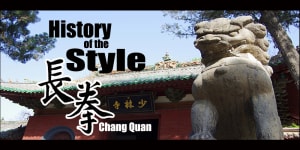
Chang Quan (Long Fist)
What is Chang Quan?
Chang Quan or “Long Fist” emphasizes fully extended kicks and striking techniques. Long Fist is a northern style martial art, and is most popular and memorable for its whirling, running, leaping and acrobatics. Contemporary Chang Quan moves are difficult to perform, requiring great flexibility and athleticism comparable to that of gymnastics. The personality or spirit behind the style is confident and elegant, with very fluid and quick motions.
Chang Quan (literally: Long Fist) is the name generally used for the styles taught by Zhao Kuan Yin, the first emperor of Sung dynasty (A.D. 960-1279). Because Zhao once learned martial arts in the Shaolin Temple, and was renowned for his staff-fighting skills during his conquest, his followers called the styles he taught “Zhang Quan” (Zhang and Chang are two different pronunciations of the Chinese character ), which means, “The way of fist fighting taught by the Leader”. Later, two Chinese characters pronounced as Chang were used to mean long or often, and these may denote this styles long reach and wide influence, or mean that it was practiced often.
History of Chang Quan
Because there came to be a great number of practitioners of this style, its influence spread and it eventually returned to the Shaolin Temple, where it became known as the Chang Quan Style or the Tai Zhu Style (Tai Zhu means “The Grand Forefather”).
The popularity of the style in the Ming dynasty (1368-1644) can be gleaned from a passage in Ji Shiao Shin Shu, a famous military guidebook written by Chi Ji Guang (1528-1587), the most legendary general of this dynasty, who organized effective coastal defenses against raging Japanese pirates:
The second way of interpreting Chang Quan is to consider its name as reflective of its combat techniques. The distinction between long fist and short fist was used like an old ad in the Ming dynasty and refers to the range from which the practitioners would strike. Generally, four northern styles are considered the typical constituents of Long Fist because these styles generally strike from as far as possible and practitioners extend their bodies widely in their moves while utilizing swift and forceful strikes. The four styles are Cha Quan (Chais a family name of Muslim origin), Hua Quan (Hua is a family name), Pao Quan (Cannon Fist) and Hong (Red) Quan. A major concept held by their practitioners is “An inch longer, an inch stronger.”
The third possible interpretation of Chang Quan refers to the new style Hsin Wushu (literally: “new” martial art), established by official endeavor in mainland China relatively recently. This style is also known as Contemporary Chang Quan and was created by government officials and incorporates the characteristics of the four styles of long fist mentioned earlier, mixing the external aspects of martial art movements and gymnastic leaps and balances into one new form. The purpose for this official form was to standardize the forms so the performances could be evaluated in contests. Because of the great emphasis on muscle strength, flexibility and leaping, this form is mostly suitable only for athletes.


